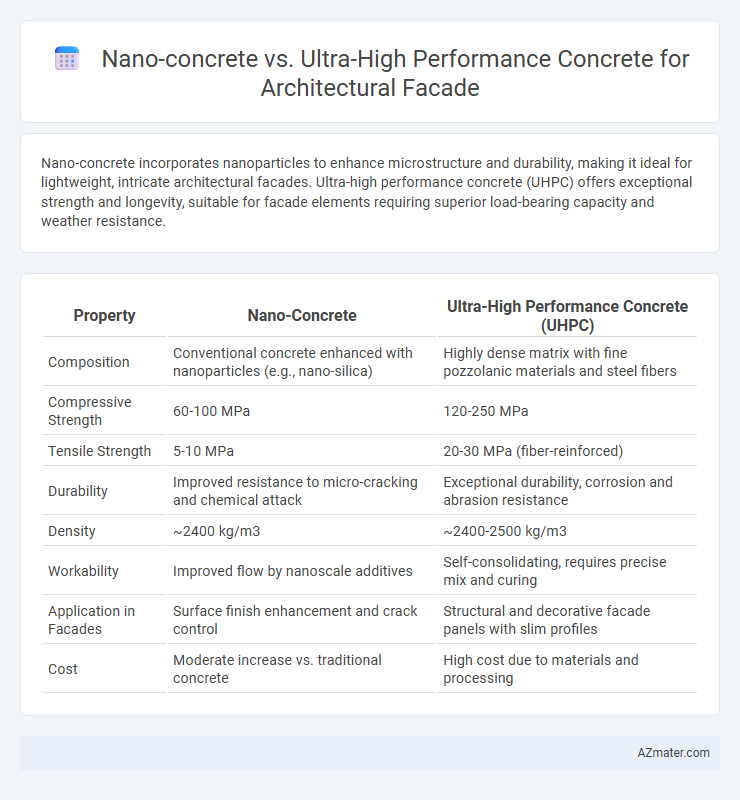Nano-concrete incorporates nanoparticles to enhance microstructure and durability, making it ideal for lightweight, intricate architectural facades. Ultra-high performance concrete (UHPC) offers exceptional strength and longevity, suitable for facade elements requiring superior load-bearing capacity and weather resistance.
Table of Comparison
| Property | Nano-Concrete | Ultra-High Performance Concrete (UHPC) |
|---|---|---|
| Composition | Conventional concrete enhanced with nanoparticles (e.g., nano-silica) | Highly dense matrix with fine pozzolanic materials and steel fibers |
| Compressive Strength | 60-100 MPa | 120-250 MPa |
| Tensile Strength | 5-10 MPa | 20-30 MPa (fiber-reinforced) |
| Durability | Improved resistance to micro-cracking and chemical attack | Exceptional durability, corrosion and abrasion resistance |
| Density | ~2400 kg/m3 | ~2400-2500 kg/m3 |
| Workability | Improved flow by nanoscale additives | Self-consolidating, requires precise mix and curing |
| Application in Facades | Surface finish enhancement and crack control | Structural and decorative facade panels with slim profiles |
| Cost | Moderate increase vs. traditional concrete | High cost due to materials and processing |
Introduction to Advanced Concrete Technologies
Nano-concrete incorporates nanoscale additives such as silica nanoparticles to enhance durability, mechanical strength, and surface smoothness, making it ideal for intricate architectural facades requiring precision and aesthetic appeal. Ultra-high performance concrete (UHPC) combines high cement content, fine powders, and fiber reinforcement to achieve exceptional compressive strength exceeding 150 MPa and superior toughness, enabling slender, lightweight facade elements with increased longevity. Both advanced concrete technologies offer transformative solutions in architectural design by improving structural performance, enhancing material efficiency, and enabling innovative facade geometries that respond to modern engineering and aesthetic demands.
Defining Nano-Concrete: Composition and Properties
Nano-concrete is characterized by the incorporation of nanoparticles such as silica, titanium dioxide, or carbon nanotubes within the cement matrix, significantly enhancing its microstructure and mechanical properties. These nanoparticles improve hydration reactions, leading to increased density, reduced porosity, and superior durability compared to conventional concrete. Its unique composition enables exceptional strength and self-cleaning or photocatalytic properties, making nano-concrete highly suitable for innovative architectural facade applications.
Understanding Ultra-High Performance Concrete (UHPC)
Ultra-High Performance Concrete (UHPC) is a cutting-edge material known for its exceptional strength, durability, and enhanced aesthetic versatility, making it ideal for architectural facades requiring sleek, modern designs combined with longevity. Composed of fine powders such as silica fume and optimized with steel fibers, UHPC offers superior tensile strength and resistance to environmental degradation compared to traditional concretes, including nano-concrete variants. Its low porosity and high density allow for thinner, lighter panels without compromising structural integrity, delivering innovative facade solutions in complex architectural applications.
Mechanical Strength Comparison
Nano-concrete exhibits enhanced mechanical strength due to the inclusion of nanoparticles that refine the microstructure, resulting in superior compressive and tensile performance compared to traditional concrete. Ultra-high performance concrete (UHPC) surpasses nano-concrete in mechanical strength, offering compressive strengths commonly above 150 MPa and exceptional flexural strength, which is crucial for load-bearing architectural facades. The advanced fiber reinforcement and optimized particle packing in UHPC provide significantly higher durability and resistance to mechanical stresses, making it the preferred choice for demanding facade applications.
Durability and Weather Resistance
Nano-concrete exhibits enhanced durability through its improved microstructure, reducing porosity and increasing resistance to freeze-thaw cycles and chemical attacks compared to conventional concrete. Ultra-high performance concrete (UHPC) offers superior weather resistance due to its dense matrix and high compressive strength, making it highly resistant to abrasion, chloride penetration, and environmental degradation. Both materials excel in architectural facade applications, but UHPC's exceptional mechanical properties provide longer service life under extreme weather conditions.
Aesthetic Flexibility for Architectural Façades
Nano-concrete offers enhanced surface smoothness and fine detail retention, enabling intricate and delicate facade designs with high aesthetic flexibility. Ultra-high performance concrete (UHPC) provides superior strength and durability, allowing for slender, lightweight panels that maintain complex shapes and textures over time. Combining both materials can optimize facade aesthetics by balancing precision detailing with long-lasting structural integrity.
Sustainability and Environmental Impact
Nano-concrete incorporates nanoparticles to enhance material density and durability, reducing maintenance and extending facade lifespan, which lowers overall environmental impact. Ultra-high performance concrete (UHPC) offers superior strength and longevity with minimal material use, significantly cutting CO2 emissions during production and lifecycle. Both technologies support sustainable architectural facades by improving structural efficiency and reducing carbon footprints, with UHPC often favored for its combination of mechanical performance and eco-friendly attributes.
Cost-Efficiency and Construction Practicality
Nano-concrete offers enhanced cost-efficiency for architectural facades due to its lower material consumption and reduced curing time compared to ultra-high performance concrete (UHPC), which demands specialized materials and longer curing periods. Construction practicality favors nano-concrete with its easier mixing, placement, and adaptability to complex shapes, whereas UHPC requires highly skilled labor and precise equipment for proper handling. Both materials provide superior durability and aesthetics, but nano-concrete is often preferred in budget-sensitive projects aiming for intricate facades with quicker turnaround.
Case Studies: Real-World Applications
Case studies reveal that nano-concrete enhances architectural facades by improving durability and self-cleaning properties through nanoscale additives, as demonstrated in the Shanghai Tower's facade panels. Ultra-high performance concrete (UHPC) exhibits superior strength and flexibility, enabling intricate designs and slim profiles, highlighted by the Museum of Modern Art in Warsaw's complex facade. Both materials optimize facade performance, but nano-concrete is favored for surface treatment benefits while UHPC excels in structural innovation and aesthetic complexity.
Choosing the Right Concrete: Key Considerations for Architects
Nano-concrete offers enhanced durability and self-healing properties ideal for complex architectural facades requiring fine detailing and longevity against environmental stress. Ultra-high performance concrete (UHPC) provides superior compressive strength and abrasion resistance, making it suitable for sculptural and load-bearing facade elements demanding minimal maintenance. Architects must evaluate factors such as structural demands, aesthetic goals, environmental exposure, and lifecycle costs to choose the right concrete for optimal facade performance.

Infographic: Nano-concrete vs Ultra-high performance concrete for Architectural façade
 azmater.com
azmater.com